HTML
--> --> -->There emerge several Higgs production mechanisms at e+e? colliders: Higgsstrahlung, WW fusion and ZZ fusion, etc.. Around
The leading order (LO) prediction for e+e? → ZH was first considered in 70s [7-10]. In the early 90s, the next-to-leading order (NLO) electroweak correction for this process has also been addressed by three groups independently [11-13], which turns out to be significant. Very recently, the mixed electroweak-QCD next-to-next-to-leading (NNLO) corrections were also be independently calculated by two groups [14, 15]. The
From the experimental angle, it is the decay products of the Z0 boson, rather than the Z0 itself that are tagged by detectors in the Higgsstrahlung channel, since the Z0 is an unstable particle. Therefore, in order to get closer contact with experiment, it is advantageous to make precise predictions directly for the process
The LO contribution to the
The purpose of this work is to conduct a systematic investigation on the higher-order radiative corrections to the process e+e?→μ+μ-H, to match the projected experimental precision at CEPC. We first compute the NLO weak correction to e+e?→μ+μ-H, then proceed to include the
The rest of the paper is structured as follows. In Section 2, adopting the Breit-Wigner ansatz for the resonant Z0 propagator, we recapitulate the LO prediction for e+e?→μ+μ-H and also show the corresponding NWA result. In Section 3, we specify our strategy of implementing the finite Z0-width effect in higher-order calculation. In Section 4, we present the calculation for the NLO weak correction to this channel. In Section 5, we describe the calculation for the mixed electroweak-QCD corrections. In Section 6, we present the numerical results and phenomenological analysis. Finally we summarize in Section 7.
| $\begin{eqnarray}{e}^{+}({k}_{1})+{e}^{-}({k}_{2})\to {\mu }^{+}({p}_{1})+{\mu }^{-}({p}_{2})+H({p}_{H}), \end{eqnarray}$ | (1) |
At Higgs factory, lepton masses can be safely neglected owing to their exceedingly small Yukawa couplings. Consequently at the lowest order, there is only a single s-channel diagram as depicted in Fig. 1. The LO amplitude reads
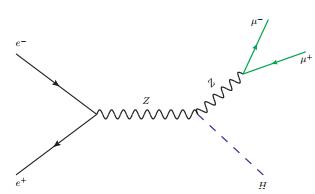 Figure1. (color online) LO diagram for e+e?→μ+μ-H.
Figure1. (color online) LO diagram for e+e?→μ+μ-H.| $\begin{eqnarray}\begin{array}{ll}{\mathop{ {\mathcal M} }\limits^{\sim }}_{0}&=-\frac{{e}^{3}{M}_{Z}}{{s}_{W}{c}_{W}}\bar{v}({k}_{1}){\Gamma }_{Z}^{\mu }u({k}_{2})\frac{{g}_{\mu \nu }}{(s-{M}_{Z}^{2})({s}_{12}-{M}_{Z}^{2})}\\&\times \bar{u}({p}_{1}){\Gamma }_{Z}^{\nu }v({p}_{2}), \end{array}\end{eqnarray}$ | (2) |
As can be readily seen from Fig. 1, it is possible for the μ+μ- pair to be resonantly produced from the on-shell Z0 boson, consequently the amplitude in (2) blows up at
| $\begin{eqnarray}{ {\mathcal M} }_{0}= {\mathcal F} {\mathop{ {\mathcal M} }\limits^{\sim }}_{0}, {\mathcal F} =\frac{{s}_{12}-{M}_{Z}^{2}}{{s}_{12}-{M}_{Z}^{2}+i{M}_{Z}{\Gamma }_{Z}}, \end{eqnarray}$ | (3) |
The LO cross section is then given by
| $\begin{eqnarray}{\sigma }_{0}=\frac{1}{2s}\displaystyle \int {\rm{d}}{\Pi }_{3}\frac{1}{4}\displaystyle \sum _{{\rm{Pol}}}{|{ {\mathcal M} }_{0}|}^{2}, \end{eqnarray}$ | (4) |
| $\begin{eqnarray}\begin{array}{ll}\displaystyle \int {\rm{d}}{\Pi }_{3}&=\displaystyle \int \frac{{{\rm{d}}}^{3}{p}_{1}}{{(2\pi )}^{3}2{p}_{1}^{0}}\frac{{{\rm{d}}}^{3}{p}_{2}}{{(2\pi )}^{3}2{p}_{2}^{0}}\frac{{{\rm{d}}}^{3}{p}_{H}}{{(2\pi )}^{3}2{p}_{H}^{0}}\\&\times {(2\pi )}^{4}{\delta }^{(4)}({k}_{1}+{k}_{2}-{p}_{1}-{p}_{2}-{p}_{H})\\&=\frac{1}{{(2\pi )}^{4}}\frac{1}{16\sqrt{s}}\displaystyle \int \frac{{\rm{d}}{s}_{12}}{\sqrt{{s}_{12}}}{\rm{d}}{\Omega }_{1}^{* }{\rm{d}}\cos {\theta }_{H}|{{\boldsymbol{p}}}_{1}^{* }||{{\boldsymbol{p}}}_{H}|, \end{array}\end{eqnarray}$ | (5) |
Squaring (2), summing over μ+μ- helicities, and averaging upon the e+e? polarizations, one observes that the squared amplitude bears a factorized structure, thanks to the simple s-channel topology. Substituting it into (4), integrating over the solid angle
| $\begin{eqnarray}\begin{array}{ll}\frac{{{\rm{d}}}^{2}{\sigma }_{0}}{{\rm{d}}{s}_{12}{\rm{d}}\cos {\theta }_{H}}=&\frac{{\alpha }^{3}{({g}_{Z}^{+2}+{g}_{Z}^{-2})}^{2}}{24{c}_{W}^{2}{s}_{W}^{2}}\frac{|{{\boldsymbol{p}}}_{H}|{M}_{Z}^{2}}{\sqrt{s}{(s-{M}_{Z}^{2})}^{2}}\\&\times \frac{{s}_{12}}{{({s}_{12}-{M}_{Z}^{2})}^{2}+{M}_{Z}^{2}{\Gamma }_{Z}^{2}}\left(2+{\sin }^{2}\theta \frac{{{\boldsymbol{p}}}_{H}^{2}}{{s}_{12}}\right), \end{array}\end{eqnarray}$ | (6) |
Integrating (6) over the polar angle, one obtains the Born-order spectrum of the invariant mass of μ+μ-:
| $\begin{eqnarray}\begin{array}{ll}\frac{{\rm{d}}{\sigma }_{0}}{{\rm{d}}{M}_{\mu \mu }}&=\frac{{\alpha }^{3}{({g}_{Z}^{+2}+{g}_{Z}^{-2})}^{2}}{9{c}_{W}^{2}{s}_{W}^{2}}\frac{|{{\boldsymbol{p}}}_{H}|{M}_{Z}^{2}}{\sqrt{s}{(s-{m}_{Z}^{2})}^{2}}\\&\times \frac{{s}_{12}^{3/2}}{{({s}_{12}-{M}_{Z}^{2})}^{2}+{M}_{Z}^{2}{\Gamma }_{Z}^{2}}(3+\frac{{{\boldsymbol{p}}}_{H}^{2}}{{s}_{12}}).\end{array}\end{eqnarray}$ | (7) |
| $\begin{eqnarray}\mathop{\mathrm{lim}}\limits_{{\Gamma }_{Z}\to 0}\frac{1}{{({s}_{12}-{M}_{Z}^{2})}^{2}+{M}_{Z}^{2}{\Gamma }_{Z}^{2}}=\frac{\pi }{{M}_{Z}{\Gamma }_{Z}}\delta ({s}_{12}-{M}_{Z}^{2})\end{eqnarray}$ | (8) |
| $\begin{eqnarray}{\left.\frac{{\rm{d}}{\sigma }_{0}}{{\rm{d}}\cos {\theta }_{H}}\right|}_{{\rm{NWA}}}=\frac{{\rm{d}}{\sigma }_{0}(ZH)}{{\rm{d}}\cos \theta }{{\rm{Br}}}_{0}(Z\to {\mu }^{+}{\mu }^{-}), \end{eqnarray}$ | (9) |
| $\begin{eqnarray}\frac{{\rm{d}}{\sigma }_{0}(ZH)}{{\rm{d}}\cos \theta }=\frac{\pi {\alpha }^{2}({g}_{Z}^{+2}+{g}_{Z}^{-2})}{4{c}_{W}^{2}{s}_{W}^{2}}\frac{|{{\boldsymbol{p}}}_{H}|{M}_{Z}^{2}}{\sqrt{s}{(s-{M}_{Z}^{2})}^{2}}\left(2+{\sin }^{2}\theta \frac{{{\boldsymbol{p}}}_{Z}^{2}}{{M}_{Z}^{2}}\right), \end{eqnarray}$ | (10) |
| $\begin{eqnarray}{\Gamma }_{0}(Z\to {\mu }^{+}{\mu }^{-})=\frac{\alpha }{6}({g}_{Z}^{+2}+{g}_{Z}^{-2}){M}_{Z}, \end{eqnarray}$ | (11a) |
| $\begin{eqnarray}{{\rm{Br}}}_{0}(Z\to {\mu }^{+}{\mu }^{-})\equiv \frac{{\Gamma }_{0}(Z\to {\mu }^{+}{\mu }^{-})}{{\Gamma }_{Z}}.\end{eqnarray}$ | (11b) |
| $\begin{eqnarray}{\sigma }_{0}({\mu }^{+}{\mu }^{-}H){|}_{{\rm{NWA}}}={\sigma }_{0}(ZH){{\rm{Br}}}_{0}(Z\to {\mu }^{+}{\mu }^{-}), \end{eqnarray}$ | (12) |
| $\begin{eqnarray}{\sigma }_{0}(ZH)=\frac{\pi {\alpha }^{2}({g}_{Z}^{+2}+{g}_{Z}^{-2})}{3{c}_{W}^{2}{s}_{W}^{2}}\frac{|{{\boldsymbol{p}}}_{H}|{M}_{Z}^{2}}{\sqrt{s}{(s-{M}_{Z}^{2})}^{2}}\left(3+\frac{{{\boldsymbol{p}}}_{Z}^{2}}{{M}_{Z}^{2}}\right).\end{eqnarray}$ | (13) |
| $\begin{eqnarray} {\mathcal M} ={ {\mathcal M} }_{0}+{ {\mathcal M} }^{(\alpha )}+{ {\mathcal M} }^{(\alpha {\alpha }_{s})}+\cdots .\end{eqnarray}$ | (14) |
Once going beyond LO, it becomes a quite delicate issue to incorporate the finite Z width effect yet without spoiling gauge invariance and bringing double counting. Over the past decades, numerous practical schemes have been proposed to tackle the unstable particle, such as the pole scheme [31-33], factorization scheme [34, 35], fermion-loop scheme [36, 37], boson-loop scheme [38], complex mass scheme [39, 40], etc.. It is worth mentioning that a systematic and model-independent approach, the unstable particle effective theory, has also emerged finally [41, 42]. However, this approach is valid only near the resonance peak, and cannot be applied in the entire kinematic range.
Owing to the particularly simple s-channel topology of our process, it is most convenient to employ the factorization scheme [34, 35], which is particularly suitable for such resonance-dominated process. In this scheme, one rescales a gauge-invariant higher-order amplitude by a Breit-Wigner factor
For our purpose, we specify the recipe of the factorization scheme closely following [25]:
| $\begin{eqnarray}{ {\mathcal M} }^{(\alpha {\alpha }_{s}^{n})}= {\mathcal F} {\mathop{ {\mathcal M} }\limits^{\sim }}^{(\alpha {\alpha }_{s}^{n})}+i\frac{{\rm{Im}}\{{\hat{\Sigma }}_{T}^{ZZ\, (\alpha {\alpha }_{s}^{n})}({M}_{Z}^{2})\}}{{s}_{12}-{M}_{Z}^{2}}{ {\mathcal M} }_{0}, \end{eqnarray}$ | (15) |
1) By default, the pole mass of the Z0 is determined by the condition
The second term in the right-hand side of (15) is included to subtract the double-counting term. Fortunately, due to its orthogonal phase, the interference of this term with
Once the rescaled
| $\begin{eqnarray}{\sigma }^{(\alpha {\alpha }_{s}^{n})}=\frac{1}{2s}\displaystyle \int {\rm{d}}{\Pi }_{3}\frac{1}{4}\displaystyle \sum _{{\rm{Pol}}}2{\rm{Re}}[{ {\mathcal M} }_{0}^{* }{ {\mathcal M} }^{(\alpha {\alpha }_{s}^{n})}], \end{eqnarray}$ | (16) |
We conclude this section by stressing that, since the non-resonant diagrams are regular at
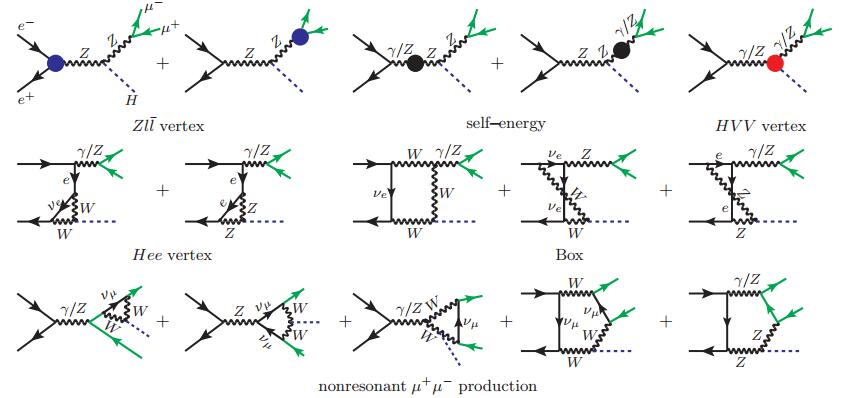 Figure2. (color online) Some representative higher-order diagrams for e+e?→μ+μ-H, through the order-ααs. The three solidheavy dots are explained in Fig. 3. Diagrams in the first two rows correspond to the “resonant” channel e+e?→(Z*/γ*→)μ+μ-+H, while those in the last row exhibit a completely different “non-resonant” topology.
Figure2. (color online) Some representative higher-order diagrams for e+e?→μ+μ-H, through the order-ααs. The three solidheavy dots are explained in Fig. 3. Diagrams in the first two rows correspond to the “resonant” channel e+e?→(Z*/γ*→)μ+μ-+H, while those in the last row exhibit a completely different “non-resonant” topology.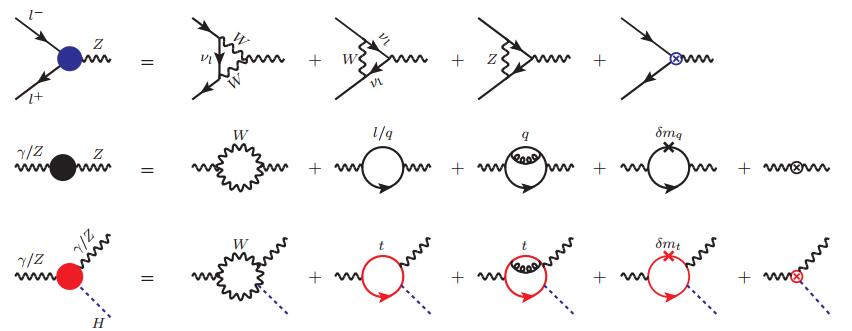 Figure3. (color online) Representative diagrams for the radiative corrections to the renormalized Zee vertex, γ/Z self-energy, and HVV vertex, through order-ααs. The cross represents the quark mass counterterm in QCD, cap denotes the electroweak counterterm in on-shell scheme.
Figure3. (color online) Representative diagrams for the radiative corrections to the renormalized Zee vertex, γ/Z self-energy, and HVV vertex, through order-ααs. The cross represents the quark mass counterterm in QCD, cap denotes the electroweak counterterm in on-shell scheme.The NLO amplitude is computed in Feynman gauge. Masses of all light fermions are neglected except the top quark. Dimensional regularization (DR) is employed to regularize UV divergence. The Feynman diagrams and the corresponding amplitude are generated by the package FeynArts [44]. Tensor contraction and Dirac/color matrices trace are conducted by using FeynCalc and FeynCalcFormLink [45-47]. Tensor integrals are further reduced to the Passarino-Veltman scalar functions, which are numerically evaluated by Collier [48] and LoopTools [49].
We also choose to use the standard on-shell renormalization scheme to sweep UV divergences, where various electroweak counterterms are tabulated in [50]. Depending on the specific recipe for the charge renormalization constant Ze, there are three popular sub-schemes of the on-shell renormalization: α(0), α(MZ) and Gμ schemes [13]. In the first scheme, the fine structure constant α is assuming its Thomson-limit value, whereas α(0) is replaced with
| $\begin{eqnarray}\alpha ({M}_{Z})\, =\frac{\alpha (0)}{1-\Delta \alpha ({M}_{Z})}, \end{eqnarray}$ | (17a) |
| $\begin{eqnarray}{\alpha }_{{G}_{\mu }}\, =\frac{\sqrt{2}}{\pi }{G}_{\mu }{M}_{W}^{2}{s}_{W}^{2}, \end{eqnarray}$ | (17b) |
Once the
For the actual two-loop computation, we utilize the packages Apart [51] and FIRE [52] to perform partial fraction and integration-by-parts (IBP) reduction. We then combine FIESTA [53]/CubPack [54] to perform sector decomposition and subsequent numerical integrations for master integrals with quadruple precision.
Besides the finite renormalization of Zee vertex [15], the
| $\begin{eqnarray}\begin{array}{ll}{\mathop{ {\mathcal M} }\limits^{\sim }}^{(\alpha {\alpha }_{s})}&=\displaystyle \sum _{{V}_{1}, {V}_{2}=Z, \gamma }\frac{-{e}^{2}}{{s}^{2}-{M}_{{V}_{1}}^{2}}\bar{v}({k}_{1}){\Gamma }_{{V}_{1}, \mu }u({k}_{2})\bar{u}({p}_{1})\\&\times {\Gamma }_{{V}_{2}, \nu }v({p}_{2})\frac{1}{{s}_{12}-{M}_{{V}_{2}}^{2}}(-ie){T}_{{V}_{1}{V}_{2}H}^{\mu \nu }(K, P), \end{array}\end{eqnarray}$ | (18) |
By Lorentz covariance, the renormalized vertex tensor
| $\begin{eqnarray}\begin{array}{ll}{T}_{H{V}_{1}{V}_{2}}^{\mu \nu }&={T}_{1}\frac{{K}^{\mu }{K}^{\nu }}{s}+{T}_{2}{P}^{\mu }{P}^{\nu }+{T}_{3}\frac{{K}^{\mu }{P}^{\nu }}{s}+{T}_{4}\frac{{P}^{\mu }{K}^{\nu }}{s}\\&+{T}_{5}{g}^{\mu \nu }+{T}_{6}{\epsilon }^{\mu \nu \alpha \beta }\frac{{K}^{\alpha }{P}^{\beta }}{s}, \end{array}\end{eqnarray}$ | (19) |
Substituting (19) into (18), utilizing the factorization scheme (15) to implement the finite Z0 width effect, we then obtain the rescaled amplitude
| $\begin{eqnarray}\begin{array}{ll}\frac{{\rm{d}}{\sigma }^{(\alpha {\alpha }_{s})}}{{\rm{d}}{s}_{12}}&=\frac{{\alpha }^{3}{M}_{Z}}{9{c}_{W}{s}_{W}\sqrt{s}}{| {\mathcal F} |}^{2}\\&\times \displaystyle \sum _{{V}_{1}, {V}_{2}=Z, \gamma }\frac{({g}_{{V}_{1}}^{-}{g}_{Z}^{-}+{g}_{{V}_{1}}^{+}{g}_{Z}^{+})({g}_{{V}_{2}}^{-}{g}_{Z}^{-}+{g}_{{V}_{2}}^{+}{g}_{Z}^{+})}{(s-{M}_{Z}^{2})(s-{M}_{{V}_{1}}^{2})}\\&\times \frac{{s}_{12}|{{\boldsymbol{p}}}_{H}|}{({s}_{12}-{M}_{Z}^{2})({s}_{12}-{M}_{{V}_{2}}^{2})}{{\mathcal{T}}}_{{V}_{1}{V}_{2}}, \end{array}\end{eqnarray}$ | (20) |
| $\begin{eqnarray}{{\mathcal{T}}}_{{V}_{1}{V}_{2}}=\frac{{{\boldsymbol{p}}}_{H}^{2}}{2}\left(\frac{1}{{s}_{12}}-\frac{{M}_{H}^{2}}{{s}_{12}s}+\frac{1}{s}\right){T}_{4}+\left(\frac{{{\boldsymbol{p}}}_{H}^{2}}{{s}_{12}}+3\right){T}_{5}.\end{eqnarray}$ | (21) |
The angular distribution of Higgs boson at
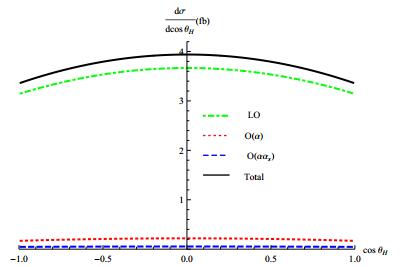 Figure4. (color online) Angular distribution of the Higgs boson at
Figure4. (color online) Angular distribution of the Higgs boson at 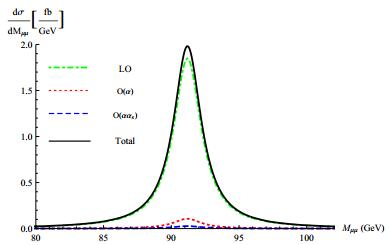 Figure5. (color online) μ+μ- invariant mass spectrum at
Figure5. (color online) μ+μ- invariant mass spectrum at In Table 1, we supplement more details for the dimuon invariant mass spectrum. We divide the NLO weak correction into the contribution from the resonant diagrams and the one from non-resonant diagrams. As can be seen from the Table 1, the
 | 50 | 70 | 80 | 85 | 90 | 91 | 92 | 95 | 100 | 110 | σ | |
| LO/fb | 0.66 | 2.39 | 8.03 | 24.45 | 309.02 | 570.98 | 407.45 | 53.27 | 9.66 | 1.31 | 6.9828 | |
| resonant/fb | 0.04 | 0.14 | 0.47 | 1.42 | 17.78 | 32.82 | 23.39 | 3.05 | 0.55 | 0.07 | 0.4015 | |
| nonresonant (10?4/fb) | 65 | 39 | 22 | 12 | 1 | 0 | -0 | -7 | -16 | -24 | 8.5 | |
| 0.01 | 0.04 | 0.13 | 0.35 | 4.54 | 8.37 | 5.97 | 0.79 | 0.15 | 0.02 | 0.103 | ||
Table1.Differential cross section with respect to the μ+μ- invariant mass at
Our goal is to present to date the most comprehensive predictions for the e+e? → μ+μ-H process, taking into various sorts of theoretical uncertainties account. In Table 2, we present our LO, NLO, NNLO predictions for the integrated cross section at
| schemes | σLO/fb | σNLO/fb | σNNLO/fb | |
| 240 | α(0) | |||
| α(MZ) | ||||
| Gμ | ||||
| 250 | α(0) | |||
| α(MZ) | ||||
| Gμ |
Table2.The total cross section for e+e?→μ+μ-H at
From Table 2, we observe a very similar pattern of scheme and parametric dependence of higher-order corrections as [15]. While the parametric and scale uncertainties of the NNLO predictions in the α(0) and α(MZ) schemes are both about 0.5% of the NNLO results, the relative errors are somewhat reduced in the Gμ scheme (≈0.2%). We also find that in the Gμ scheme, the mixed electroweak-QCD corrections only amount to 0.4% of LO cross section, which might be attributed to the fact that in addition to the running of α, universal corrections to the ρ parameter are also absorbed into the LO cross section. As can also be seen in Table 2, though the predicted LO cross sections from three renormalization schemes differ significantly, including the NLO weak correction significantly help them converge to each other. Including mixed electroweak-QCD correction appears not to further reduce the scheme dependence. To yield a scheme-insensitive prediction, it appears to be imperative to continue to compute the NNLO electroweak correction, which is certainly an extremely daunting task.
Since ΓZ?MZ, and the production rate is predominantly saturated by the Z0 resonance. It may seem natural to anticipate that the NWA remains valid even after including higher order corrections. Under the assumption of NWA, one may approximate the LO cross section and the higher-order radiative corrections by
| $\begin{eqnarray}{\sigma }_{0}{|}_{{\rm{NWA}}}={\sigma }_{0}(ZH){{\rm{Br}}}_{0}(Z\to {\mu }^{+}{\mu }^{-}), \end{eqnarray}$ | (22a) |
| $\begin{eqnarray}\begin{array}{ll}{\sigma }^{(\alpha )}{|}_{{\rm{NWA}}}&={\sigma }^{(\alpha )}(ZH){{\rm{Br}}}_{0}(Z\to {\mu }^{+}{\mu }^{-})\\&+{\sigma }_{0}(ZH){{\rm{Br}}}^{(\alpha )}(Z\to {\mu }^{+}{\mu }^{-}), \end{array}\end{eqnarray}$ | (22b) |
| $\begin{eqnarray}\begin{array}{ll}{\sigma }^{(\alpha {\alpha }_{s})}{|}_{{\rm{NWA}}}&={\sigma }^{(\alpha {\alpha }_{s})}(ZH){{\rm{Br}}}_{0}(Z\to {\mu }^{+}{\mu }^{-})\\&+{\sigma }_{0}(ZH){{\rm{Br}}}^{(\alpha {\alpha }_{s})}(Z\to {\mu }^{+}{\mu }^{-}), \end{array}\end{eqnarray}$ | (22c) |
| $\begin{eqnarray}\begin{array}{ll}{\rm{Br}}(Z\to {\mu }^{+}{\mu }^{-})=&{{\rm{Br}}}_{0}(Z\to {\mu }^{+}{\mu }^{-})+{{\rm{Br}}}^{(\alpha )}(Z\to {\mu }^{+}{\mu }^{-})\\&+{{\rm{Br}}}^{(\alpha {\alpha }_{s})}(Z\to {\mu }^{+}{\mu }^{-})+\cdots .\end{array}\end{eqnarray}$ | (23) |
In Table 3, we compare the predicted e+e?→μ+μ-H cross section from the literal full calculation with that from NWA. For the sake of concreteness, we take
| LO | NLO | NNLO | |
| σ/fb | 6.983 | 7.385 | 7.488 |
| σ|NWA/fb | 7.241 | 7.657 | 7.760 |
Table3.Compare the full and NWA predictions to the cross sections at
To make closer contact with the actual experimental measurement, in this work we have investigated both NLO weak and mixed electroweak-QCD corrections to one of the golden mode in CEPC, i.e. e+e?→μ+μ-H, with the finite Z0 width properly accounted. At
We also carefully address the issue about scheme-dependence of our predictions, at various levels of perturbative accuracy. Employing three popular renormalization sub-schemes, we find that the predicted LO cross sections substantially differ from each other. Including the NLO weak correction is crucial to stabilize the predictions from different schemes, however including mixed electroweak-QCD correction seems not to help. To yield a scheme-insensitive prediction, it appears to be compulsory to continue to include the NNLO electroweak correction.
We are grateful to Gang Li and Qing-Feng Sun for useful discussions.
